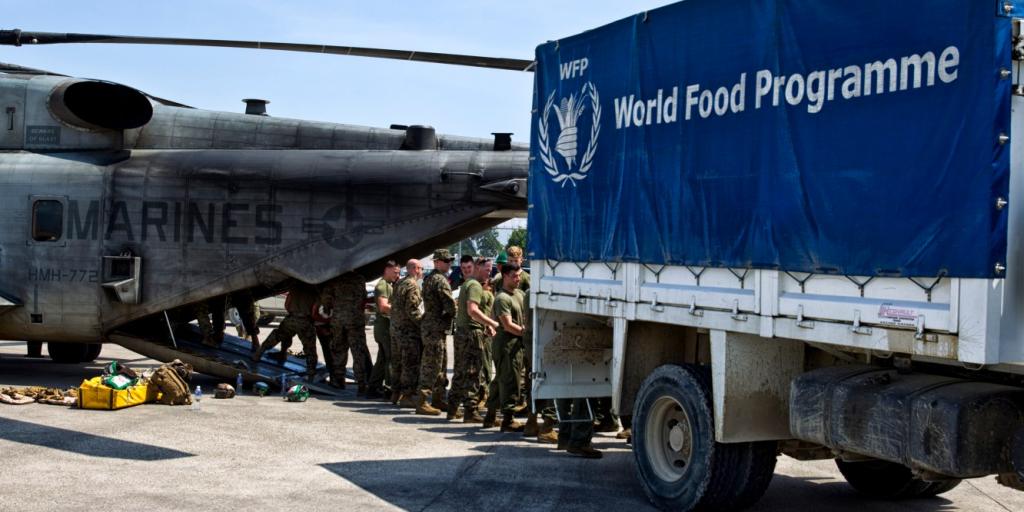By Kristin Bergtora Sandvik, Larissa Fast, Adele Garnier, Katja Lindskov Jacobsen, and Maria Gabrielsen Jumbert
This year’s Nobel Peace Prize is awarded to the World Food Programme for its “efforts to combat hunger, for its contribution to bettering conditions for peace in conflict-affected areas and for acting as a driving force in efforts to prevent the use of hunger as a weapon of war and conflict”. The announcement emphasizes the importance of supporting – and funding – international solidarity and multilateralism in a world in crisis. The WFP is praised for its work in extremely difficult conditions and for gaining access to populations in war zones like Syria and closed dictatorships like North-Korea.
Together with the struggle against slavery and the provision of medical assistance to wounded soldiers, the fight against famine is the original humanitarian cause. Images of starving victims in Biafra in the late 1960s and then again in Ethiopia in the 1980s mobilized TV audiences and humanitarian efforts to ensure food delivery. Today, as the economic and health consequences of the Covid-19 pandemic devastate the livelihoods of communities globally, the WFP estimates that an unprecedented 138 million people is in need of food aid.
In her announcement, the Chairwoman of the Committee, Berit Reiss-Andersen, described food as “the best vaccine against chaos”. Asked if she expected that this year’s prize would be uncontroversial, Reiss-Andersen hoped that giving the Nobel Peace Prize to an organization helping to end starvation would not be provocative, indicating that food-aid was non-political. Whatever the reception, we argue this is nevertheless a deeply political choice, due to the assumptions it makes about food as an instrument of peace, about the linkages between humanitarianism and peace and finally about the World Food Programme as an international organization.
This contribution first puts the opening quote in context, showing how food is currently framed as an instrument of peace. It then focuses on the very political nature of the WFP as a multilateral humanitarian organization within the global environment, even as the emphasis of the Nobel Peace Prize is on its role in “saving lives”. Finally, it discusses one example of the WFP at the operational level: the politics of humanitarian technology.
Food as an instrument of peace
In 2015, hunger eradication became one of the UN’s Sustainable Development Goals. As Reiss-Andersen indicated in the Nobel Peace Prize announcement, the WFP is the “UN’s primary instrument for realizing this goal”. In 2018, the UN Security Council adopted Resolution 2417, recognizing the link between famine and conflict, and reasserting the importance of international humanitarian law in addressing hunger in armed conflict. Echoing this, the 2020 Nobel Peace Prize is presented first and foremost through the lens of the insecurity that is created when food supply is insufficient, or controlled by warring parties, and thereby praising the WFP’s contributions to making “food security an instrument of peace”.
Improving the conditions for peace requires much more than providing food; it necessitates political commitment to promote and preserve peace
This peace-humanitarian nexus, however, is problematic. The prize recognizes the existential threat that a lack of food causes for human life and the importance of preventing the use of food as a weapon of war. The struggles against the Irish and Russian famines were foundational moments in modern humanitarianism. Yet throughout history, mass starvation has been mis-categorized as natural phenomenon, or as an unfortunate side-effect of conflict and political oppression. Scholars have disputed this narrative, focusing instead on the infrastructures of food-distribution and the political underpinnings of famine and mass starvation. The politics of famine are fierce, as exemplified by the heated discussion of whether the food shortages in Niger in 2005 amounted to a famine at all – and whether that mattered. While the focus on early warning systems and increasingly fine-grained measurements of access to nutrition in real time has provided the international community with increasingly accurate tools for predicting and addressing food-shortages, these mechanisms remain prone to interference. And as the Nobel committee notes, the WFP (and other humanitarian actors) can do little in the face of endemic funding shortages.
Thus, defining what constitutes a famine, and thereby who should respond to it, with which means and requirements, are deeply political questions. Just as hunger can be a weapon of war, so can food aid be instrumentalized in conflict settings. Improving the conditions for peace requires much more than providing food; it necessitates political commitment to promote and preserve peace.
Published in collaboration with PRIO
This is an excerpt. To read the full article, visit The Global.
Interested in contributing to our blog? Here is how.


